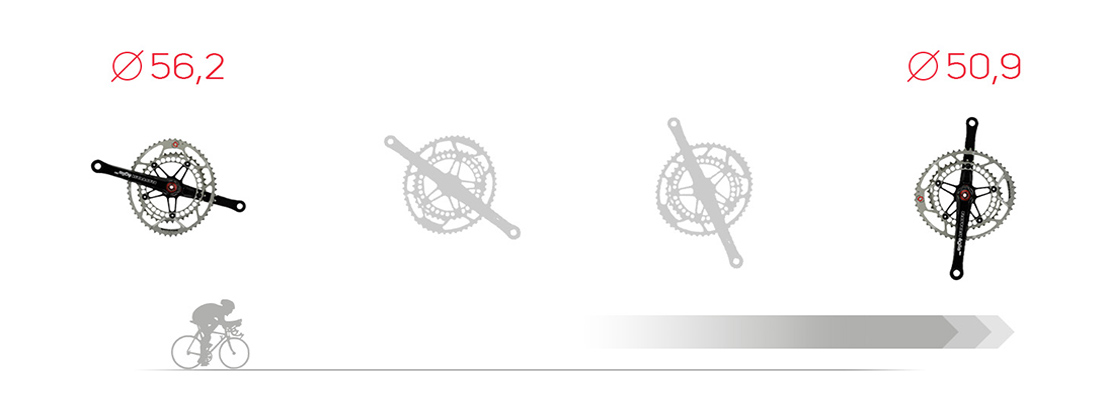Q-RINGS
Q-rings make your spin cycle smoother, make climbing easier on the legs and helps reduce the build up of lactates during hard efforts. Pros tell us they are great for stage racing and blocks of training. Please download and read this 'guide to adaptation' before preceeding to buy Q-rings.
Our Premium stockist scheme ensures that customers can ride a bike with Q Rings before they buy. They will also stock Cervelo team 3D cranks and all items supplied by ROTOR.
Rotor Q-Rings minimize the dead spots like reducing the size of a regular chainring, and give you more time during the pedal down stroke. This allows for a lower physical demand on your body, so you are able to ride longer with less fatigue, climb easier…
HOW IT WORKS
Rotor Q-Rings do not eliminate the dead-spot (as do Rotor Cranks) but help to reduce its negative effects, moving the legs easier through the dead spot imitating a smaller circular chainring, and enabling the legs to remain in the power stroke for a longer period of time when compared to round chainrings. Q-Rings change the equivalent tooth size by decreasing it before the dead-spots and increasing it when the rider is in the power mode (when more power is available at the pedal down stroke).

A 53T Q-Ring, around the upper dead-spot is equivalent to a 51T, but as the pedal goes down and more strength is applied (just passed the maximum power moment), the equivalent chainring tooth size reaches 56T.
FEAUTURES AND BENEFITS
OCP (Optimum Chainring Position), a Rotor patented feature is the secret to success, where others have failed. The OCP system allows you to choose the angle where you obtain the maximum gear ratio, customizing pedaling to each and every cyclist, where it is needed most. Since the maximum power moment is different for every cyclist (performance is different depending on pedaling style and position on the bike), the OCP System customizes the Rotor Q-Rings to your geometry and cycling habits, and takes maximum advantage of alternative leg inertias on every pedal rotation. OCP is Rotor Q-Ring's bio-mechanical key!
More uniform power delivery due to the modulation of the gear ratio every moment. Rotor Q-Rings are designed to obtain a soft, comfortable way of pedaling with uniform muscular work, so they allow an easy and quick adaptation. Rotor Q-Rings give a smoother power transfer, helping to maintain traction on slippery surfaces, and to avoid the bobbing effect on suspension bikes. Mitigation of knee pains: Since Q-Rings imitate a circular (but smaller) chainring around the dead spots, minimize muscle requirements at the dead- spots, just when your knees need it.
- More uniform power delivery due to the modulation of the gear ratio every moment. Rotor Q-Rings are designed to obtain a soft, comfortable way of pedaling with uniform muscular work, so they allow an easy and quick adaptation. Rotor Q-Rings give a smoother power transfer, helping to maintain traction on slippery surfaces, and to avoid the bobbing effect on suspension bikes.
- Mitigation of knee pains: Since Q-Rings imitate a circular (but smaller) chainring around the dead spots, minimize muscle requirements at the dead- spots, just when your knees need it.
ABOUT TECHNOLOGY
Lightweight & Quality: CNC machined from the highest quality aluminium, with a special nickel plated finish for extreme wear resistance. Latest technology with simplest mechanics: Q-Rings are user friendly; easy to install and easy to find and change the regulation setting through the patented OCP System. Affordable: prices are within the reach of every cyclist.
Designed and patented by ROTOR: Innovation and performance through our engineering at the service of the cycling community. Fits most high-end bikes: Q-Rings are available in the following versions:
- Road 53/40T for Shimano and other cranks using the 130 BCD (bolt pattern).
- Road 53/41T for Campagnolo and other cranks using the 135 BCD.
- Road 50/36 for FSA and other Compact cranks using the 110 BCD (not valid for Campagnolo Compact).
- MTB 44/34/24T for MTB cranks 104/64 BCD (Shimano XT and similar).
(Other Q-Ring sizes will become available in the future).
What is the difference between Q-RINGS and other non circular chainrings?
he design of Q-RINGS comes from Rotor Cranks biomechanical technology more so than from any previous oval or asymmetrical type chainring. Non circular chainrings have been available in various shapes since the late 1890's. All of them attempted to avoid the negative affects of the dead spot. The most recent models that are well known are the Shimano Bio-Pace and the O.SYMETRIC "Harmonic".
The ROTOR Q-RINGS are different from these two types, and all other previous types inasmuch as Q-RINGS:
- Q-RINGS take into consideration the forces from your legs in static conditions in addition to the inertia of the bicycle, the rider and the legs of the rider.
- Q-RING provide a smooth rhythmic pedaling motion instead of the high-gear-low-gear feeling and high accelerations at the dead spots.
- Q-RINGS position the equivalent high gear about 20 degrees past the power-side-crank's horizontal position, which is the approximate place where you can obtain the maximum benefit of the higher gear.
- Q-RINGS have the OCP (Optimum Chainring Position) enabling you to customize (fine tune) the position of the chainring for your personal riding habits and riding position on the bike.
- Q-RINGS mitigate pain and damage to the knees that is usually caused by the dead spots; if your knees feel pain they cannot deliver maximum power; when the pain is removed, your performance will clearly increase.